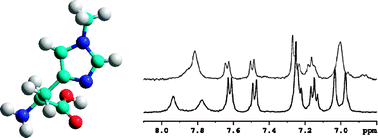The complex-formation behaviour of His residues in the fifth Cu2+ binding site of human prion protein: a close look†
Abstract
Human Prion

* Corresponding authors
a
Dipartimento di Chimica, Università di Ferrara, via L. Borsari 46, 44100 Ferrara, Italia
E-mail:
maurizio.remelli@unife.it
Fax: +39 0532 240709
Tel: +39 0532 455150
b Dipartimento di Chimica, Università di Siena, Via A. Moro 2, 53100 Siena, Italia
c Faculty of Chemistry, University of Wroclaw, F. Joliot-Curie 14, 50383 Wroclaw, Poland
d Dipartimento di Scienze Farmaceutiche, Università di Ferrara, via Fossato di Mortara 17/19, 44100 Ferrara, Italia
Human Prion

 Please wait while we load your content...
Something went wrong. Try again?
Please wait while we load your content...
Something went wrong. Try again?
M. Remelli, D. Valensin, D. Bacco, E. Gralka, R. Guerrini, C. Migliorini and H. Kozlowski, New J. Chem., 2009, 33, 2300 DOI: 10.1039/B9NJ00202B
To request permission to reproduce material from this article, please go to the Copyright Clearance Center request page.
If you are an author contributing to an RSC publication, you do not need to request permission provided correct acknowledgement is given.
If you are the author of this article, you do not need to request permission to reproduce figures and diagrams provided correct acknowledgement is given. If you want to reproduce the whole article in a third-party publication (excluding your thesis/dissertation for which permission is not required) please go to the Copyright Clearance Center request page.
Read more about how to correctly acknowledge RSC content.
 Fetching data from CrossRef.
Fetching data from CrossRef.
This may take some time to load.
Loading related content
